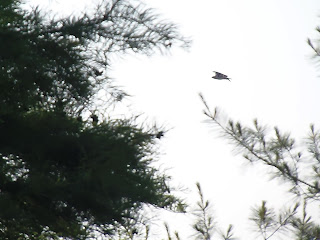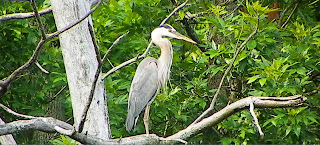The other day I witnessed something I've certainly not seen before…a woodpecker being
chased off the feeder! Not only that....but by a Mourning Dove! Doves seem so
docile and unassuming when we watch them feeding (they even put up with the
cowbirds!) but Cyril the Red-bellied Woodpecker decided the dove was too close
on the feeder, and I saw him peck his long beak toward the dove aggressively. The dove would
have none of that and I saw it spread its wings and walk toward the woodpecker
with its head in full-pecking motion. Cyril flew off and the dove promptly went
back to eating, undoubtedly quite pleased with itself. I doubt Cyril will be put off for long though.
The face-off was between the seemingly non-confrontational Mourning Dove....
...and Cyril, the Red-bellied Woodpecker, who we never thought would ever be pushed off of any feeder. Even the massive flocks of Cowbirds give way to the woodpeckers!
Learn to live and let live, Cyril! There's plenty of food for all of you. :)
Another of our regular critters that I've yet to talk about is "our" raccoon that we have named Nelson. Nelson, while annoying since he not only eats up anything in and out of sight, but raccoons are destructive. They will pick up absolutely everything, if there's nothing of use to consume, it just gets tossed over their shoulder so that we even get to clean up after them, including broken bits and bobs.
They can also certainly be entertaining, as most animals are if you stop and watch. He has done some
amazing feats (i.e., pulled a 35-lb bag of seed off stacked tubs to the ground)
and some absolutely hilarious mishaps (i.e., missing a tree
while jumping to it from our roof to escape David and on another occasion, jumping from the roof
down to a window ledge, where we had put some birdseed…one night I looked over to see his nose and eyes peeking over the top of the ledge while
one of his paws tried to reach the seed, only to find himself plummeting to the
ground since he actually needed both hands…I mean paws…to hold on). We should
have known better to leave our new tube-feeder out…yes, he of course jumped on
it and it’s now on the ground with no seed in it.
A few nights ago, David caught Nelson scouring our deck for
food (as usual), except this time he was after the dog’s food bowl that had
been left outside. Busted!
As Nelson grabbed one side to pull it off the table, David sneaked up to it and grabbed the other side…and a tug of war ensued. Nelson would pull the bowl toward him, David would pull it back...Nelson grabbed it again and pulled...well, you get the picture. Nelson, doing what raccoons do, then pulls if off the table so he could run off with the whole thing and get rid of the human interloper.
David then successfully retrieved the bowl, while Nelson ultimately scampered off and let David win this round…for now
"What can I destroy and eat here?"
Yeah...as I said, for now. Nelson certainly isn't going to let some seed go to waste, now is he?
It's also hazardous having Nelson on our front deck at night, because once I opened the door to let one of our cats, Rosie, inside when I thought I heard her...except it was Nelson who had just knocked over a bucket of seed and was just outside the front door when I opened it. Not having my glasses on, at first I nearly ushered Nelson in, thinking it was Rosie! Well, in my defense, it was also nighttime! She does resemble a raccoon....

The Barn Swallows have decided to nest in the workshop area
this year (last year it was near the back of the house). They are breeding visitors
here, and they wasted no time getting down to business! Not that we mind since
they feed almost entirely on insects, which they pick out of the air in their quick,
graceful flights. They are 5 ½ - 7” in length, with the tail deeply forked;
glossy dark blue above, light rufous below, with darker throat. They prefer
open woodlands, other open areas, farmlands, and suburbs. Similar to the Cliff
Swallow, the Barn Swallow also builds their mud nests in culverts, under
wharves and bridges, and inside sheds, garages and barns.
These photos were taken by David around May 25th, when the nest was being built.
You can hopefully see the bit of stuff in its beak, ready to put on the nest.
The nest...a work in progress...
The next set of photos were taken earlier this month. The swallow likes to perch on this wire since it is a prime spot for juicy insects.
Might as well have a nice preen while waiting.
Hmmm...I spy with my little eye....
Food!
The Barn Swallow nest now...
...and inconsiderately put where it's impossible to take photos! haha
Before the start of the fall migration, Barn Swallows join
with other swallow species to form huge flocks that rest and preen on telephone
wires. It seems the Barn Swallow has adjusted to man and man’s interference on
nature quite nicely!
I was peeking through photos from one year ago, and what should I see but photos of Cliff Swallows, that I mentioned earlier in this post, taken when David was out and about in the canoe around Barren Creek on June 12, 2012. Quite the serendipitous find since I happened to mention them today!
Cliff Swallows are 5 - 6" in length with mostly dark above, light forehead, rusty rump and throat, square tail. They are found in open country cliffs, farmlands with bridges or buildings for nesting, usually near water. Their natural nest sites are cliffsides, but like the Barn Swallows have adapted and take advantage of man's "contributions" to their habitats. They are also breeding visitors here (obviously!).
Their nests are quite different from the Barn Swallow, and it appears they are inclined to have a community of nests. Quite the flurry of activity!
These are the swallows that return to the Mission of San Juan Capistrano, in California, on or about March 19th of each year.
David was able to get a great shot of a heron that day as well, as he was out on Barren Creek spying on Cliff Swallows.
The Barn Swallow was also photographed at that time, on June 10th 2012, when the nest was at the back of the house.
It was amazing to see the difference between June 10th 2012 and June 10th 2013. We had a much cooler Spring here this year, and have had rains occasionally whereas last year we were already into the 90s and under drought conditions (and it got worse!).
These Gladiolus flowers were already blooming by this time...and look at that grass! It was already "crunchy" under our feet.
This year these flowers haven't bloomed yet and are growing much taller. By the end of the drought later that summer, our area was considered "exceptional" for drought conditions. This year the grass is lush and green and the forest is amazing; you can feel the cool breezes come out of the forest and there is more wildlife around since the conditions are more bearable with an abundance of food, flora, and water.
I have definitely smiled to myself when it has rained (as it did earlier today!) and have been very thankful that thus far it's been a wonderful Spring.
Until next time....


























































